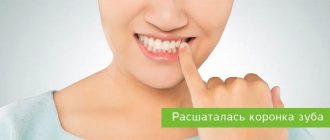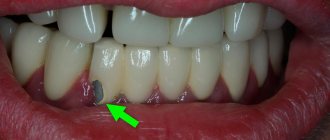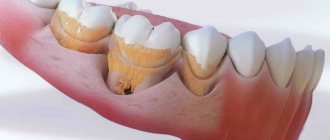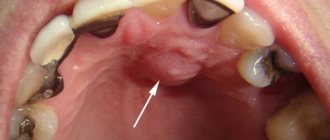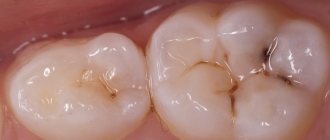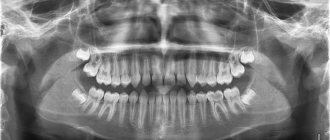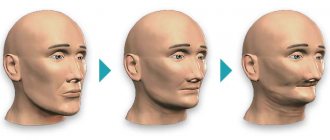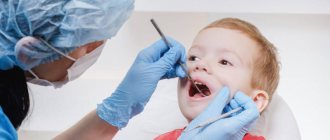Teeth have physiological activity that is not noticeable to a non-specialist. Teeth movement occurs due to the fact that the tooth is not tightly fixed into the bone alveolus, but has a shock-absorbing fastening system in the form of periodontal tissue. That is why the chewing load is evenly distributed over the surface, and the teeth maintain their integrity. However, tooth mobility sometimes becomes pathological. Most often, if parents did not make obvious mistakes in childhood, this phenomenon occurs in people of mature or middle age. Movements that are very difficult to visually record are considered normal for tooth mobility. When mobility becomes noticeable even to the owner of the teeth, then we are talking about a disease.
Did you know that all dental pathologies can be cured with aligners?
I want to know more about the movement of teeth on aligners
A classification of this pathological process of tooth movement has been created:
- During the first stage,
the teeth move back and forth or, in medical terms, have vestibulo-orally directed mobility. - When, in addition to this, the teeth make movements in lateral directions, the second stage
. - At the most dangerous stage, the third stage
, vertical and circular movements are added to those mentioned earlier. The teeth are already beginning to emerge from the bone alveoli.
If the first two stages are subject to treatment and have a certain chance of recovery, then the last stage of mobility is a kind of sentence - the tooth should be removed.
Symptoms accompanying mobility
In fact, there is only one symptom - when you touch a tooth with your finger, tongue or any object, as well as during eating, its mobility is clearly felt. As a rule, horizontally, that is, a shift to the right-left or forward-backward. Other symptoms are mainly associated with the underlying disease and, as a rule, we are talking about inflammation of the gums, exposure of the roots, the formation of copious amounts of deposits under the soft mucous membranes, even rotting of the contents of periodontal pockets.
What is the cause of pathological mobility of teeth?
The well-known disease periodontitis is the main cause of this problem. This disease is inflammatory in nature and is characterized by destruction and reduction of tissue adjacent to the tooth. Dental deposits cause inflammation of the gums, which spread to the surrounding bone and ligaments. Inflamed tissue dissolves very quickly and is replaced by granulation tissue. And as a result of the fact that there is no more bone, the teeth acquire pathology in the form of mobility.
Adjuvant therapy
The main treatment involves auxiliary therapy aimed at preventing further loosening of the teeth. It includes:
- prescription of anti-inflammatory drugs, vitamins, biostimulants;
- ointments, gels to strengthen gums;
- antibiotic therapy;
- systematic professional teeth cleaning;
- physiotherapy (electrophoresis, plasma lifting, etc.);
- gum massage
If the front tooth becomes loose after an impact or several lower units become mobile due to bleeding gums, treatment should begin as quickly as possible. Complex therapy in the early stages around the moving element will help to form healthy tissue, ensuring reliable retention of the tooth in the gum. In complex, advanced cases, with 4 degrees of mobility, removal followed by prosthetics is advisable.
How do teeth move during orthodontic treatment?
A little theory about tooth movement
With the help of connective tissue fibers, the tooth is secured in the dental socket. This ligament is called the priodontal ligament. When the walls of the tooth socket are constantly exposed to the force coming from the aligners to straighten the teeth, areas of tension and pressure appear in the periodontium. Restructuring processes of bone tissue begin to occur in the tooth socket, which trigger bone resorption (resorption) and then its construction (osteogenesis). In the area of pressure, the periodontal fissure contracts, and in the area of tension, expansion occurs. Under pressure, the fibers of the ligament of the tooth and the nerves and blood vessels located in these places are compressed. The surface of the alveoli, located at the root of the tooth, experiences resorption.
In the area of tension, the ligaments of the tooth are stretched, and the process of bone tissue formation occurs. Both of these processes occur simultaneously, but with varying intensity, depending on the stage of treatment. The desired movement can only be achieved by applying a certain force to the jaw and teeth. Empirically, it has been found that less force exerted by aligners to correct a bite results in faster tooth movement. This is explained by the specific processes of regeneration and resorption of dental tissue and alveolar structures. This is why orthodontic tooth movement is a slow process, produced in the desired direction under the influence of small forces. If you make a greater load to move the teeth, the neurovascular bundles will not have time to rebuild in time. Without sufficient innervation and proper blood flow, the position of the tooth is difficult to correct.
Now let's see how teeth move in practice when treating orthodontic pathologies.
Tooth movement in the treatment of dental crowding
How crowded teeth are moved into a straight position using aligners
The clinical director of the Star Smile company, orthodontist Alexander Veniaminovich Spesivtsev, comments on the process of tooth movement:
— Let’s pay attention in the top video to how the upper and lower jaws come into contact with each other at the end of the treatment situation: we see an excellent position, excellent inclination of the front teeth, excellent shape, coincidence of all midlines, all linear parameters. Which, in general, allows us to think that the patient as a whole should be satisfied with this result.
The most important thing - as you have already noticed by watching the video - is that one of the key points of the aligner treatment technology is the creation of a 3D virtual setup
. That is, you and I sit in front of the computer and see WHAT will happen as a result of treatment BEFORE it starts. This emphasis is made on purpose, since many of us find it difficult to understand in principle how teeth move.
This kind of technology, this kind of 3D image, provides the answers. Therefore, look, analyze and begin your orthodontic journey in correcting your not very straight teeth!
Tooth movement during crossbite treatment
This patient has a crossbite. We see not a very narrow, but on the contrary, a very wide skirt-like shape of the upper central incisors. In aligner technology, we very often use a variety of different ways to adjust the size of teeth in order to create room for alignment. Therefore, here, as they say, “your hands are itching” to intervene in the situation and a little - let’s say - “file” the teeth on the sides to make them more attractive. And thereby create the optimal place for leveling.
A 3D virtual setup shows how straight his teeth will become with a crossbite
Quite classic tasks are faced by every doctor who shows a 3D virtual setup to a patient. The setup shows how the position of the teeth changes, how the shape changes slightly. On the lower jaw and on the upper jaw on the left we see the not entirely correct position of the last two teeth, two molars: the upper one tilts very strongly towards the buccal side, and the lower one, on the contrary, tilts towards the tongue. This is a crossbite. The video shows the movement of all teeth to their normal position.
Diagnostics
Diagnosis begins with collecting anamnesis. The dentist finds out when the tooth began to become very loose, whether this happened before, and what chronic diseases the patient has. Next, a dental examination of the oral cavity is carried out, the general condition of the dentition and periodontium is assessed. The degree of unsteadiness is assessed according to the subjective sensations of the patient and the dentist. The doctor checks the direction and magnitude of the deviation using tweezers:
- the instrument is applied to the upper part of the dental crown and moved in different directions;
- to identify vertical or circular displacement, the crown is clamped, carefully lifted up, and rotated.
Additionally, X-ray diagnostics are performed: orthopantomogram, CT scan, targeted X-ray to identify periodontal pathologies, injuries, and assess the depth of tissue damage. Based on the results obtained, effective treatment is selected. If mobility is due to a chronic disease, a specialized specialist (endocrinologist, therapist, rheumatologist, etc.) is involved in treatment. Why the lower teeth are loose, what is causing the mobility of the upper incisor - the doctor will be able to accurately answer these questions after a comprehensive dental examination.
Did you know that all dental pathologies can be cured with aligners?
Star Smile company is a leading Russian manufacturer of aligners.
The design of each set of aligners for patients is based on accurate mathematical modeling of the physiology of patient tooth movement, taking into account the existing pathology. What does it mean? This means that your teeth will be put in place as quickly and comfortably as possible with the help of Star Smile aligners! Star Smile specialists work in more than 70 (!) cities of Russia. We can always advise you in your city for free. And the main thing is to cure it once and for all with the help of aligners!
Prevention
To prevent tooth mobility, you must maintain careful oral hygiene and use brushes and pastes recommended by your doctor. Don’t forget to floss, irrigate, and rinse your mouth after eating. Regular visits to the dentist (every 6 months) for a preventive examination and professional cleaning will help identify pathology at the initial stage, avoid complications, and maintain a healthy smile.
Author of the article Voznyuk Vladimir Aleksandrovich Maxillofacial surgeon-implantologist of the highest category
Work experience: 28 years.
If the root one is unsteady
Often a healthy tooth begins to hurt sharply and become loose. Permanent teeth can also become loose, even if they are molars. You don’t need to endure it, but go to the dentist. The doctor prescribes disinfectants: rinsing with chlorhexidine and furatsilin solution, gel applications.
If the gums are inflamed, then anti-inflammatory and regenerating drugs are prescribed. (“Trental”, “Olazol”, etc.). Physiotherapy also helps stop the process. For example, vacuum massage, darsonval, ultrasound procedures.
After stopping the inflammatory processes in the oral cavity, the dentist strengthens the teeth in the correct position and applies a temporary splint. If a wisdom tooth is loose and hurts, it is most often removed since it does not play a special role in the chewing process.
How can we help you?
Find out from a specialist exactly how you should care for your teeth at home, and how to correctly use products designed for your problems and risks.
Refer to professional hygienic cleaning procedures in a timely manner to detect current problems and maintain dental health. In case of malocclusion , our specialists will select the optimal orthodontic therapy for you. It can consist of both conservative and surgical methods of correction.
If the cause of mobility in your case is periodontitis , our specialists will select the latest comprehensive treatment for you. It may also include medications and surgical methods. For high-quality prevention of complications, you will need to follow all instructions and recommendations of a specialist. Sometimes an acceptable solution for loose teeth is splinting them. But this option is not effective in all cases, and then the treating specialist decides to use other methods of treatment. If a tooth is lost, its implantation or prosthetics is indicated. Our specialists perform all types of similar services:
- Removable and fixed prosthetics;
- Implantation;
- Restoration of one or more teeth, as well as complete restoration of the dentition.
Tooth mobility of the fourth degree requires their surgical removal. The decision on the subsequent installation of prostheses or implants is made on an individual basis, taking into account the characteristics of each case.
If you notice even weak mobility of a molar, contact our dental clinic of Dr. Granov. We will provide you with the most effective and timely assistance in eliminating your problem and give valuable advice regarding the subsequent prevention of oral diseases.
